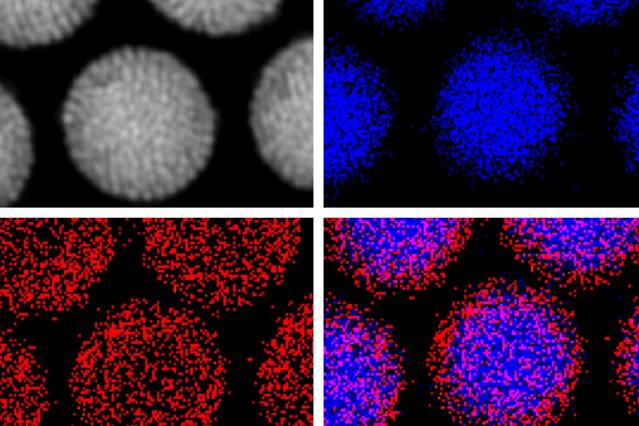 Elemental mapping of the location of iron atoms (blue) in the magnetic nanoparticles and cadmium (red) in the fluorescent quantum dots provide a clear visualization of the way the two kinds of particles naturally separate themselves into a core-and-shell structure. Image courtesy of the researchers
Elemental mapping of the location of iron atoms (blue) in the magnetic nanoparticles and cadmium (red) in the fluorescent quantum dots provide a clear visualization of the way the two kinds of particles naturally separate themselves into a core-and-shell structure. Image courtesy of the researchers
Researchers at MIT have developed a new method of producing particles which can radiate fluorescent light and be accurately positioned inside the living cells using a magnetic force.
The particles were coated with a bioreactive substance which binds with specific molecules such as disease agents or tumor cell markers inside the body. This technology helps to track the position of the nanoparticle as it moves in cells or around the body.
The senior author of this paper on this research, Moungi Bawendi, said that they desired to not just manipulate the structures within the cells using a magnetic force but also to exactly track the nanoparticle. They succeeded by creating new nanoparticles which can be tracked with high precision based on the wavelength of the emitted fluorescent light.
Using this new technique, it is possible obtain desired characteristics in an extremely compact package, which in turn could help create particles which bind with a specific bioreceptor or any other molecule.
The nanoparticles self-assemble such that the magnetic particles form as a cluster at the center, surrounded by a uniform coating of fluorescent particles. This arrangement of fluorescent molecules allows the easy identification of nanoparticles using a microscope.
The researchers stated that uniformity of the molecular structure is due to the perfect size of fluorescent nanoparticles. In early stages, the particles may be used for tracking fundamental cellular functions. Further research can enable the introduction of additional molecules to the structure to allow interaction of nanoparticles with specific targets for treatment or diagnosis.
Controllable nanoparticles
The application of electromagnets in biological research is critical to manipulate the tiny particles, otherwise the particles may disappear in a cluster of molecules moving within the cells. Additional molecules can be bound to the nanoparticles through a flexible and well-developed silica coating.
This research was reported in the journal Nature Communications.